What makes a ‘perfect’ smile?
As a cosmetic dentist, it’s the question that all of our work is based upon.
Unlike traditional dentists, who restore teeth on an individual basis, we look at the smile as a whole – including the teeth, lips, jaw and gums. And we use certain artistic and scientific principles, to decide which procedures are needed to enhance its overall appearance.
These principles are called the principles of ‘smile design’.
They’re pretty easy to understand. In fact, they can be used to evaluate your own smile at home. Here we’ve rounded up the main things to look for. So why not grab a mirror and see how your smile compares to a ‘perfect’ set of pearly whites?
9 principles of smile design
1. Symmetry

Symmetry is the key to successful smile design. This includes symmetry of the teeth, gums and lips in relation to your face as a whole.
Essentially, the midline of your central incisors should line up with the centre of your eyes, nose, and chin. Imagine a line drawn down the middle of your face. To create the ‘perfect’ smile, teeth on either side of this line – particularly at the front of the mouth – should be a mirror image.
2. Horizontal alignment

To look its best, your smile should also be parallel to an imaginary horizontal line that runs between the eyes (i.e. the inter-pupillary line).
Of course, most people’s faces are naturally asymmetrical. That’s completely normal. But to enhance the appearance of your smile, there are ways we can create the illusion of horizontal alignment of the eyes and teeth.
3. Golden proportions
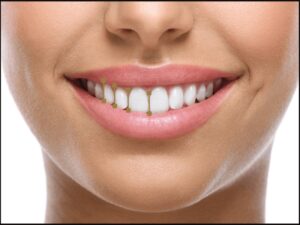
Beautiful teeth are always in perfect proportion to each other. Which is why, as a smile design dentist, we typically follow the ‘golden proportion ratio’.
From the midline, working outwards, each tooth should be approximately 65% as wide as the previous tooth. It sounds a bit confusing. But to give an example, if your central incisor is 10mm wide, your lateral incisor should be around 6.5mm wide, your first canine should be about 4.4mm wide and so on.
4. Central incisor dominance
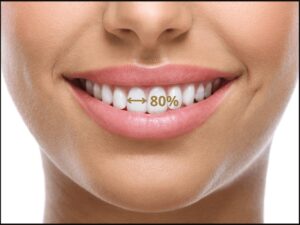
Generally speaking, your central incisors should also be wider than your other teeth and have a specific width-height ratio of approximately 80% (i.e. the width should measure 80% of the height).
What’s more, they need to be symmetrical, and the midline should run perpendicular – without canting or tilting to either the left or right.
5. Smile line
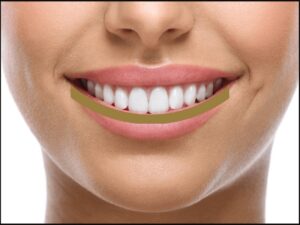
When you smile, the tips (i.e. the biting edge) of your top teeth should follow the contour of your lower lip. This is known as the ‘smile line’ and it’s one of the first things we consider as a smile design dentist.
If the smile line is particularly flat, this suggests the teeth are worn and leads to an older appearance. As such, we look for the best way to add curvature.
6. Gum line
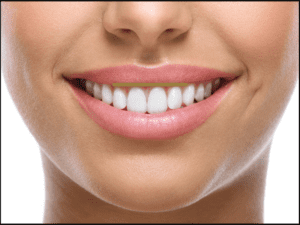
To have a nice smile, you need to have nice gums.
They should be a healthy pale pink colour and – similarly to the ‘smile line’ – your ‘gum line’ should closely follow the curvature of your upper lip.
Ideally, there should only be a small amount of gum tissue (1-3mm) visible when you smile. And the gum arcs above your central incisors, lateral incisors and canines need to be as symmetrical as possible.
7. Progressive embrasures

The chances are, as a patient, you’ve never heard of the word ‘embrasures’. But it’s another key element of smile design to be aware of – and one that can make or break the overall look of your teeth.
Embrasures are the small triangular spaces that you can see between the tips of your teeth. These should progress gradually, getting larger as you move away from the midline. And if they don’t, there are several ways in which natural-looking embrasures can be created.
8. Colour
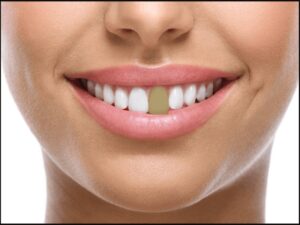
For a smile to be considered ‘perfect’, the colour of the teeth needs to be bright and consistent.
Perhaps one tooth is significantly darker than the rest? Maybe you can see white or dark spots on the enamel? Or your smile has yellowed over time?
If any of the above apply, a professional whitening treatment may be suitable to improve their appearance.
9. Character

Last but not least, are there any obvious issues with your teeth – such as black triangles, gaps, chips and cracks, misalignment, overcrowding etc.?
Not only do these affect the overall appearance of your smile, they can also negatively impact your oral health – so it’s advisable to get them fixed. Either one or a combination of cosmetic and restorative treatments may be used to do so.
Contact our ‘smile design’ dentists today

Not happy with the way your smile looks?
If – based on the principles of smile design outlined above – you think there’s room for improvement, why not get in touch and book an initial consultation with our cosmetic dentists? This is provided completely free of charge (so you have nothing to lose!) and is a great chance for us to learn more about your dental wishes, assess your smile and advise on the most appropriate treatments.
Very few of us have naturally ‘perfect’ teeth. But with the help of our experienced team – here at Kiln Lane Dental – we can help to create a healthy and beautiful smile that you can be truly proud of.
To start your ‘smile design’ journey with us, either use our online booking system to choose a date for your consultation or send an email to info@kilnlanedental.co.uk. Alternatively, if you have any questions, or would like to find out more about the cosmetic dental treatments available, feel free to call us on 01744 25776. We’re always on hand and more than happy to help.